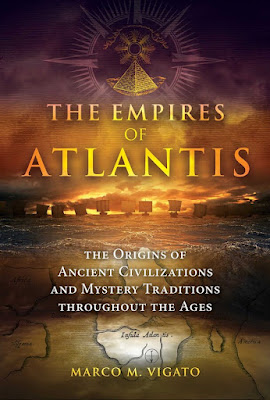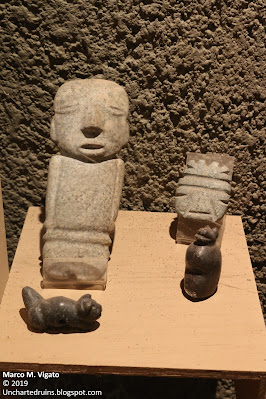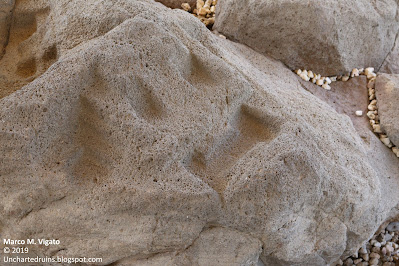In part I of this article
(Link here) we discussed the
archaeological site of San Miguel Ixtapan, Mexico, whose origins may date back
to the Pre-classic or even Formative period of Mesoamerican civilization, over
3,000 years ago. The site is known for its incredible "Maqueta" stone, the model of a city sculptured in a huge basalt rock, as well as for its unique style of megalithic architecture.
High precision megalithic stonework
Even more than its remarkable
“Maqueta” stone, perhaps the most
distinctive aspect of this remote site is the presence of some huge megalithic
stone slabs that are found both in their archaeological context as well as
reused in various civic and religious buildings of the present-day village of
San Miguel Ixtapan.
For their exceptional workmanship
and precision, these stone slabs are among the finest examples of megalithic
stone carving to be found anywhere in Mexico and Mesoamerica, being perhaps
only comparable to some of the finest specimens of Pre-Inca and Tiwanaku
stonework from South America.
Two slabs are found
embedded in the walls of the early Colonial church of San Miguel in the center
of town, with another large stela erected vertically in the church courtyard
and a fourth one standing in one corner of the main square of San Miguel
Ixtapan.
 |
| The finest and best preserved of the four carved andesite stone slabs that can be found in the center of San Miguel Ixtapan. Notice the remarkable flatness and regularity of the stone surface and the accuracy of the geometric cut, with straight edges and clear-cut right angles. [Photo by Author]. |
 |
| Another view of the same andesite stone slab in the south wall of the church of San Miguel Ixtapan. Its measures are 1.54 meters high by 1.23 meters wide, with a minimum thickness of 25 centimeters and an estimated weight of between 1-1.5 tons. [Photo by Author]. |
 |
| The very precise cut and remarkable right angles of the largest and best preserved of the andesite stone blocks found in the church of San Miguel Ixtapan. [Photo by Author]. |
 |
| Another one of the carved andesite slabs incorporated in the walls of the church of San Miguel Ixtapan. [Photo by Author]. |
 |
| A side view of the same slab, showing its thickness. [Photo by Author]. |
A fragmentary slab is
housed in the site museum of San Miguel Ixtapan, whereas two more can be found
in their archaeological context within a ceremonial space known as the “Recinto de las Esculturas” (Enclosure of
the Sculptures), located on one side of the main pyramid.
Most of the slabs in the
Church and in the main square are heavily eroded, the slab embedded in the
south wall of the Church being by far the best preserved. We took accurate measurements of the largest of the stone slabs embedded in the south wall of the church. It measures 1.54 meters high by 1.23 meters wide, with a minimum thickness of 25 centimeters and an estimated weight of between 1-1.5 tons.
All the slabs repeat the
same geometric pattern, with minimal variations: It consists of a seeming ‘T’
shape with a rectangular hollow below. On some of the slabs the carving is
plain, whereas on others the carvings are framed within a three-dimensional
double or triple molding. The carving is extremely regular, following straight
lines intersecting at right angles with the various planes of the stone
cutting. Whereas the stone is not eroded, a remarkable level of flatness and
polish is visible, which is even more remarkable if one considers that the
stone out of which the slabs were carved is a hard, finely grained type of
gray-green andesite, with a hardness of 7 on the Moh scale (comparable to 6-7
for granite).
A significant exception
to this pattern is offered by one of the slabs erected on the square in front
of the church, which contains two “knobs” (possibly some badly eroded and
defaced human head sculptures?) inside each arm of the inverted letter ‘T’.
 |
| One of the wonderfully carved stone slabs found in front of the church of San Miguel Ixtapan. Unlike the other slabs, this one has two “knobs” protruding from the arms of the letter ‘T’. [Photo by Author]. |
 |
| A close-up view of the enigmatic slab found in front of the church of San Miguel Ixtapan; notice the two "knobs" protruding out of the arms of the inverted 'T' shape, a design reminiscent of similar Andean motifs. [Photo by Author]. |
 |
| A large basalt stela, carved from a piece of columnar basalt and now laying in front of the church of San Miguel Ixtapan. [Photo by Author]. |
 |
| Fragment of another stela, this one without decoration, in one corner of the main square of San Miguel Ixtapan. [Photo by Author]. |
During our second visit
to the site on April 24th, 2021 we were accompanied by archaeologist
Victor Osorio Ogarrio, director of the archaeological site and museum of San
Miguel Ixtapan and to whom goes our unconditioned appreciation for the
excellent management of this small but very important archaeological site.
 |
| The two monolithic slabs found in situ within the “Recinto de las Esculturas” (Enclosure of the Sculptures), still in their original location. One can appreciate their different workmanship and orientation compared to the slabs in the church. The slabs on the left was covered with a white plaster stucco, apparently in an attempt to restore it after it had already suffered significant erosion. [Photo by Author]. |
 |
| Another frontal view of the two stone slabs inside the "Recinto de las Esculturas". [Photo by Author]. |
This time we had the
opportunity, thanks to Dr. Osorio, of visiting the “Recinto de las Esculturas”, located in a portion of the site that
is regularly closed to the public. There we could observe two more of the huge
stone slabs in their archaeological context. The slabs form a sort of
separation wall delimiting a space for offerings, where numerous
anthropomorphic sculptures dating to the Epiclassic period (ca. 900 AD) were
found, which are now exhibited in the local museum with the exception of two
that were left on site. The stone slab to the right of the entrance shows the
same accurate workmanship and geometric moldings as the slabs in the church.
Its orientation, however, appears to be upside down. The slab to the left is of
much inferior workmanship – It was either an attempt to replicate the same
pattern and design of the other slab, or the result of a repair attempt with
stucco of an earlier stone slab, as evidenced by the fact that stucco was
applied over a seemingly already heavily eroded surface. There is no
consistency in the orientation of the two stone slabs, the one on the right
having the ´T¨ at the bottom (upside-down from the ones in the church), the
other having the “T” shape placed horizontally. It is quite possible that the
stone slabs were only put in this chamber in secondary use and appropriated
from some earlier structure. This, together with the degree of erosion visible
on the surface of the left stone slab before it was covered with stucco, suggests
that their origin must be at least in
the Epi-classic period (to which period dates the arrangement of this chamber
and the offerings laid inside it), but could be possibly much older.
 |
| A fragment of another stone slab in one corner of the site museum of San Miguel Ixtapan (the notebook is for scale). Unlike the slabs in the church, which are made of andesite, this one is considerably thicker and made of basalt. It comes from a site close to Rancho “I” about 5 kilometers from San Miguel Ixtapan. [Photo by Author]. |
Rancho “I”
Thanks to Dr. Osorio, and
while trying to unravel the mystery of the stone slabs, our curiosity was again
picked by a carved basalt fragment housed in a corner of the site museum showing
part of a geometric frame. Unlike all the other slabs at the site and in the
church, which are made of a finely grained andesite, this fragment turned out
to be of basalt, and much thicker than any of the other slabs at approximately
0.45 meters thick.
After inquiring about the
provenance of the fragment, we learnt it was brought to the museum in the late
1990’s from a site located approximately 5 kilometers from San Miguel Ixtapan. This
site has, to the best of our knowledge, never been documented or excavated.
Attracted by the
possibility of finding more carved stone slabs at this site, we drove to Rancho
“I” based only on some very rough indications provided by locals (due to the exceptional potential importance
of this site and its lack of protection we decided not to disclose its location).
 |
| Exploring Rancho “I” with the help of a local farmer. Notice the very large mound to the left covered in huge basalt stone fragments. This is only one of several large mounds at the site. [Photo by Author]. |
There we found evidence
of what must have been a very extensive site – everywhere over a distance of
several hundred meters one could see the obvious remains of buried mounds and
pyramids, covered in fragments of basalt stone. Laying on the ground were huge
masses of heavily eroded basalt, including basalt columns and other possibly
worked rectangular stones. Near the base of one of the larger mounds we found a
huge carved basalt stone slab, broken into three pieces. If complete, the stone
must have measured at least 1.80 by 1.60 meters, with a thickness of between
0.4 and 0.5 meters and an estimated weight of between 4 and 5 tons. The design
on the stone, as well as its workmanship, is comparable to the stones in the
church and the fragment from the museum. To imagine that such exquisite
moldings were carved in the very hard basalt without iron or other metal tools
is simply astonishing.
 |
| The huge carved basalt slab found broken into three pieces at the newly discovered site of Rancho “I”. It is much thicker than the slabs at the church and made of basalt instead of andesite, yet the carving is similar. If complete, it would have measured 1.8 by 1.6 meters, with a thickness of 0.5 meters and a weight of 4-5 tons. Next to it is possible to see the excavation made by looters to remove the slab from its original site, together with numerous other pieces of wrought and unwrought basalt. [Photo by Author]. |
 |
| The largest and best preserve portion of the huge basalt stone slab at the site of Rancho "I". The two small holes were probably made by looters in an attempt to break the stone. [Photo by Author]. |
 |
| Another view of the same fragment. If complete, the slab would have measured 1.80 by 1.60 meters with a thickness of 0.5 meters and an estimated weight of 4-5 tons. [Photo by Author]. |
 |
| The author, standing behind the newly discovered carved stone slab at the site of Rancho "I". [Photo by Author]. |
According to local
farmers, the stone was discovered accidentally in the early 2000’s by treasure
hunters, who removed it from a nearby trench (now filled with smaller stone
fragments) and broke it into pieces while looking for treasure. When found, the
huge stone was apparently intact. Now only three large fragments remain, with a
fourth one (part of the letter ‘T’) missing.
It is to be hoped that
the National Institute of Anthropology and History (INAH) will decide to take
action to protect this remarkable site and remove the carved stone slab to a
place where it will suffer no further vandalism. It is very likely that more
carved stone slabs will be found at this site, which may reveal precious
information about the civilization or culture responsible for its construction,
and about the true age of the slabs.
An unknown civilization?
The type of megalithic
architecture of San Miguel Ixtapan and the exceptional quality of its stone
workmanship in such hard stones as basalt and andesite, has no parallel in
ancient Mexico, and indeed throughout Mesoamerica. This is an entirely unique
site, the silent testimony of a culture that vanished nearly without a trace
hundreds or thousands of years ago, leaving only its abandoned stone monuments
behind.
There is no consensus as
to which culture inhabited the area of San Miguel Ixtapan since at least the
Formative and Pre-classic period. Aztec documents refer to the inhabitants of
this region as the Chontal, a generic
term in the Nahua language used to indicate any foreign people of non-Nahua
descent.
Previous studies have
suggested a possible association of the site with the still enigmatic and
poorly studied Mezcala culture of Guerrero (Reyna Robles, 2006), and other
sites in the region of the Upper Balsas River.
Another possibility is
that the megalithic architectural style and artistic tradition of San Miguel
Ixtapan represents an element foreign to Mesoamerica, maybe imported by means
of trans-oceanic contact from South America. In this respect, numerous scholars
(Malmstrom, 1995) have suggested a possible relationship between the Purupecha
(or Tarascan) language spoken in parts of western Mexico, and the Quechua
language of Peru and the Andean region of South America.
Only more extensive
excavations at San Miguel Ixtapan and at the newly discovered site of “Rancho
I”, which promises to be even more extensive, may help to unravel the mystery
of the origins of this unique megalithic culture that has no other known
parallels in ancient Mesoamerica.
 |
| Some large scattered megalithic basalt blocks on the opposite side of the ravine from the archaeological site of San Miguel Ixtapan, laying in the shade of a giant tree. [Photo by Author] |
 |
| Part of a megalithic basalt wall and stone arrangement on the opposite site of the ravine from the site museum of San Miguel Ixtapan. [Photo by Author]. |
 |
| A monumental andesite pillar, nearly 2 meters high (the notebook is for scale), unfortunately defaced by graffiti, standing on one side of the parking lot of the archaeological site. Originally part of an arrangement of 3 similar pillars, it is the only one still standing. [Photo by Author]. |
 |
| A large block of columnar basalt, possibly a stela, near San Miguel Ixtapan, known locally as the “Piedra del Muerto” (Stone of the dead) for its vague resemblance to a coffin, now broken in two pieces. [Photo by Author]. |
 |
| The incredible “Maqueta” stone model of San Miguel Ixtapan, carved from a single huge boulder of basalt measuring 3 by 4 meters and believed to contain the representation of a yet unidentified city. See Part I of this article for more information. [Photo by Author]. |
Acknowledgements
We would like to thank
archaeologist Victor Osorio Ogarrio, director of the site and archaeological
museum of San Miguel Ixtapan for his kind permission to visit the “Recinto de las Esculturas” and for
accompanying us on our visit to Rancho “I”.
The opinions expressed in
this article are solely the Author’s and do not necessarily reflect the
opinions and beliefs of Dr. Osorio, of the National Institute of Anthropology
and History (INAH), or of the Secretary of Culture of the State of Mexico.
References
[1] INAH, “Zona Arqueológica de San Miguel Ixtapan”,
on January 9, 2008. On-line resource:
https://www.inah.gob.mx/zonas/46-zona-arqueologica-de-san-miguel-ixtapan. Accessed
on April 20, 2021.
[2] Malmstrom, Vincent H. “Geographical Origins of the
Tarascans”. Geographical Review, vol.
85, No. 1, January 1995, pp. 31-40.
[3] Osorio Ogarrio,
Victor Ángel and Marco Antonio de León Cortés. “Una posible Diosa Prehispánica
en San Miguel Ixtapan, Tejupilco”, Arqueología
Mexicana, 158, July-August 2019, pp. 46-51.
[4] “Revista cultural
San Miguel Ixtapan”, Expresión Antropológica,
no. 1-2 Nueva Serie. Gobierno del Estado de México: Secretaría de Cultura,
1999.
[5] Reyna Robles, Rosa
María, La Cultura Arqueológica Mezcala,
Instituto Nacional de Antropología e Historia, 2006.
[6]“San Miguel Ixtapan, Estado de México”, Arqueología Mexicana, Especial 35, Estado
de México, guía arqueológica, June 2010.
[7] Sinaí Gomez,
Rodolfo, “Antecedentes Históricos - Tejupilco”, Municipio de Tejupilco, 2012. On-line
resource. Accessed on April 25, 2021 through Archive.org: https://web.archive.org/web/20120327194635/https://www.tejupilco.gob.mx/contenido/index.php?option=com_content&view=article&id=59&Itemid=59.
[8] Wikipedia, “San
Miguel Ixtapan (Archaeological Site)”. Last edited on December 19, 2020.
On-line: https://en.wikipedia.org/wiki/San_Miguel_Ixtapan_(archaeological_site).
Accessed on April 20, 2021.

























































